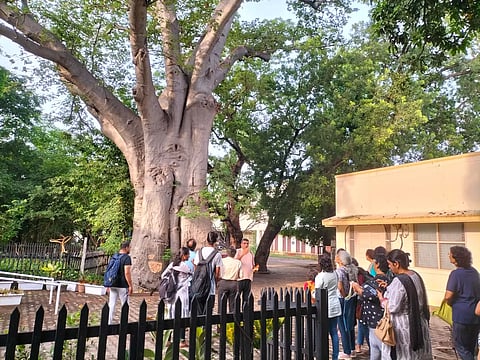

CHENNAI: For around 30-plus participants, comprising school children, college students and senior citizens, a ‘Heritage Trees of Chennai’ tour was the only opportunity to get to know about the history of the city via old trees that stand as testament to changes the city has witnessed over several decades.
To mark the 384th birthday of the metropolis, The Green Tamil Nadu Mission, along with Nizhal NGO and Rotary, organised the tour on Sunday. It covered native tree species and exotic non-invasive species across the city.
TD Babu of Nizhal, who is also the member of State Green Committee, said that the tour is the first of its kind conducted in the city to mark Chennai Day.
“Tour covering heritage structures were conducted in the city as a part of the celebrations. But trees are also part of the city’s heritage. In earlier days, trees were landmarks of localities, now buildings have taken over,” he said.
The tour commenced in Indira Nagar Park, Adyar, where a huge Indian Butter Tree (illippai maram) stands. “The tree has several economic benefits but we’re not utilising it. The flowers of the tree are sweet and can be used as a substitute for sugar. The tree naturally creates a micro climate around it,” explained Babu.
There is a baobab tree, which is a native species of Africa, standing for over 300 years inside Andhra Mahila Sabha premises. There is one inside the Government Museum in Egmore too, but garden waste and wooden slabs have been dumped around the trunk.
“This kind abuse will weaken the tree. Trunk of the baobab tree is 79% water,” he added.
The tour covered neem (veppilai) trees, Indian mahogany and Button trees that are native to the State. While neem tree provides medicines for skin diseases, the Indian mahogany belong to the timber species. While there is a native variant of mahogany tree, American mahogany is being planted widely. Timber of Button trees are used to make furniture.
“We were made to shift from wooden furniture to plastic furniture claiming that it would save trees. Now, there is demand for plastic. If wooden furniture were used, demand will grow leading to planting of more trees,” he said.
Testimonial to the fact that present land on which May Day Park and MLA Hostel were once a coastal wetland system, the park and the hostel houses neer kadamba and marutha maram (Arjuna Tree) respectively. Neer kadamba is a mangrove tree that only grows near wetlands like Arjuna tree.
“These are indicative trees. When these are present, we can deduce the area was a water body. In May Day park, a Miyawaki forest has been created around the neer kadamba maram leaving the tree without sufficient space. In MLA Hostel, paver blocks have been laid. These will kill the trees,” he lamented.
The tour ended in Queen Mary’s College that has a vajram maram (Lignum vitae), a non-invasive exotic tree with densest and hardest wood. The mission has decided to conduct similar tours on August 20, 27 and September 3.